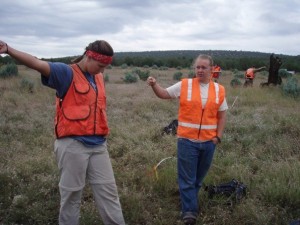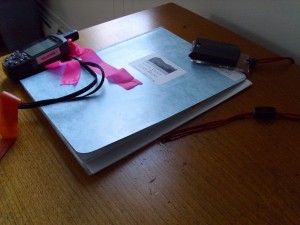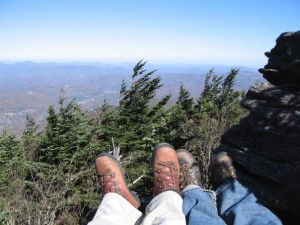Volunteer Monitoring 101 Lessons One & Two – The Art of Taking a Walk Outside
Lesson One – Do Your ‘Homework’
You may have thought your days of assigned reading followed by a quiz were over, but if you are a volunteer monitor for the Upper Valley Land Trust you are wrong – in the best way possible.
Every good monitoring visit begins when you, as the volunteer, pick up your marbled blue monitoring folder. It feels, and looks, very official with laminated pockets housing reports, background documentation, and a map collection worthy of an explorer.
The homework element comes in the form of one of the documents enclosed in this folder. The Baseline Document Report, or BDR, is part of the official legal paperwork that goes into a completed conservation easement. The purpose of the BDR is to provide a picture of that specific property at the time it is protected – including physical features, current land use, and conservation resources present. As a volunteer monitor it is your guidebook, painting a picture of what you should expect to see on your visit. If there are specific features of the land that could be a challenge to maintaining its protected status, the BDR will have those too and that is something you, as the monitor, should pay very close attention to. It is helpful to be aware of such things before you arrive on site in the chance that a violation could exist. Knowing what you’re looking at and potentially what you’re looking for is a good idea before you begin. Now, hopefully, the ‘homework’ is not looking all that bad. In fact, it is a chance to really ‘get to know’ the land.

Dangers of trekking with out proper navigation – vague pointing and guessing doesn’t work when you are a monitor! (Me, on Left, and my SCA crew in Arizona. This is where I got my first taste of large scale property management/monitoring.)
Lesson Two – Keep it Safe
Armed with this information, you are nearly ready to set out for your property visit – this would be the ‘quiz’ part. First, make sure someone knows where you are going and how long you expect to be there. This is a policy that UVLT staff members follow and recommend strongly to volunteers. Directions to the site are included in the monitoring folder but you will also need to know where you’re going once you arrive.
A handheld GPS unit can be acquired from the UVLT office that includes the boundaries of conserved properties, but be aware! All maps are imperfect representations of the real thing so it is best to bring along a compass in addition to your GPS and your paper maps to ensure that you are indeed tromping on conserved property and not the next door neighbor’s!
When you arrive be sure to park in a safe area and note where your vehicle is located (this can be done with the GPS). UVLT can provide you with a “UVLT Monitoring Visit†sign to display in your window, another recommended practice. Double check that you have all the gear you need and, if you haven’t already, plan your monitoring route through the property.
Each route will be different depending on the challenges that may/may not exist as well as what was done the year before. The idea isn’t to replicate the same visit from year to year, though you should take that visit under advisement. Rather, your trip is to make sure the property is thoroughly inspected with the overarching goal of your observations being to add to a complete picture of the property over time. Sometimes the land owner or caretaker will come with you and it is great if they do. These visits are an opportunity to keep in touch and maintain a good relationship with them.
“Lesson” Three – Have Fun!
Then, the adventure begins! And while every visit you do may not be action packed it will most certainly be a memorable experience. Since monitoring visits only happen once a year they are critical to UVLT’s ability to properly care for the land we have protected. Out there you, the volunteer, are our eyes and ears, and sometimes we hear some very neat stories. But even if we don’t, and the visit is quiet, it is still your excuse to take a walk in the woods, fields, and farms of the Upper Valley; with your mind and eyes open you might just come away with something better than a story.
This is the first post of a series I am writing about my experience becoming a fully trained monitor for UVLT. I came to the Land Trust with some field experience but I knew it was unlikely that the methods I had been taught would be an exact fit for UVLT’s stewardship needs – and boy was I right! I hope you will enjoy learning, laughing, and pondering with me as I collect and nurture the knowledge, skills, and abilities gained from spending time outside.
Anna Slack, UVLT Programs Coordinator, Monitor-in-Training
** If you’re interested in becoming a monitor yourself contact us! **



